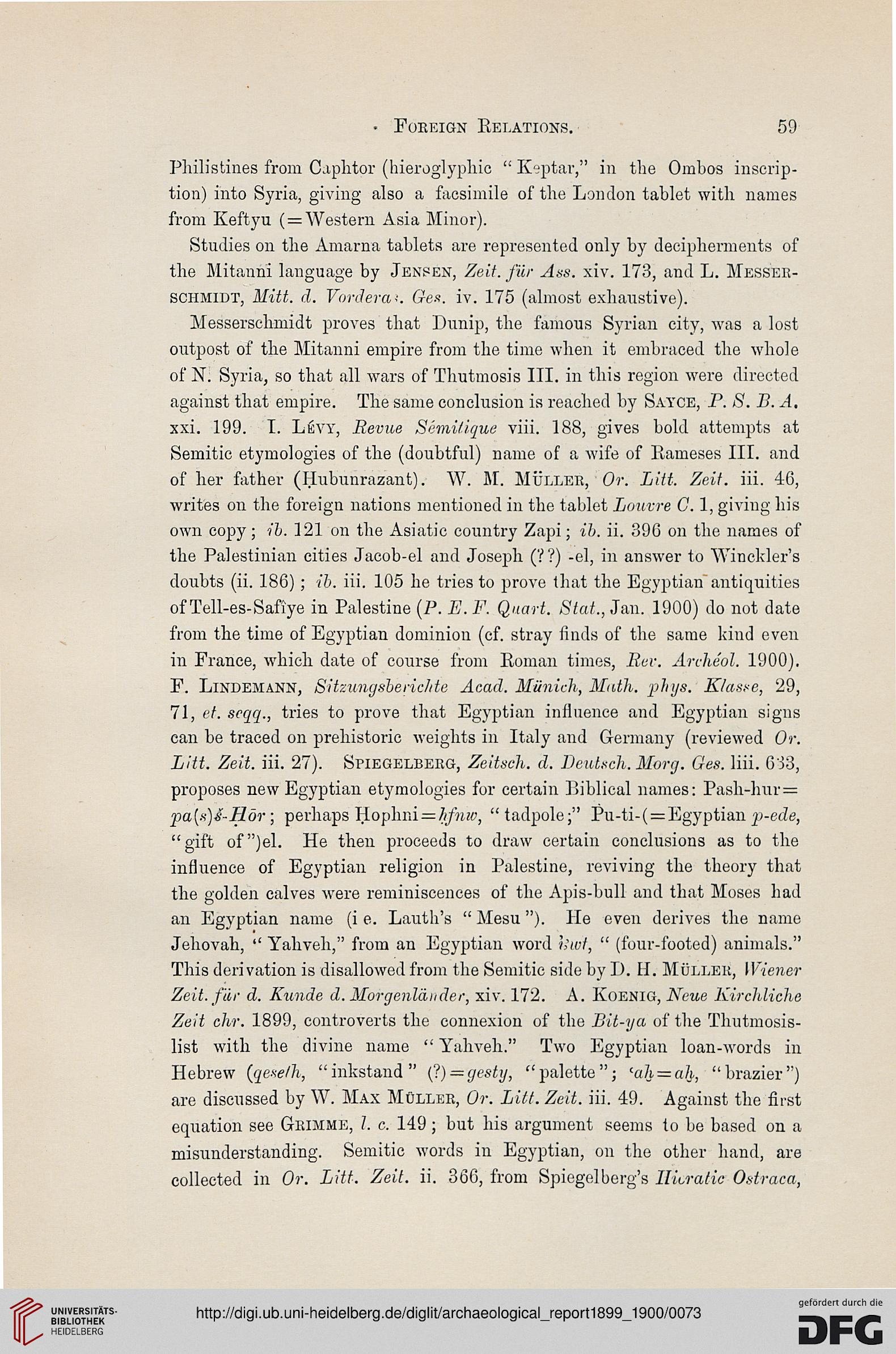Foreign Relations.
59
Philistines from Caplitor (hieroglyphic " Keptar," in the Ombos inscrip-
tion) into Syria, giving also a facsimile of the London tablet with names
from Keftyu ( = Western Asia Minor).
Studies on the Amarna tablets are represented only by decipherments of
the Mitanni language by Jensen, Zeit. fur Ass. xiv. 173, and L. Messer-
schmidt, Mitt. d. Vordera:. Ges. iv. 175 (almost exhaustive).
Messerschmidt proves that Dunip, the famous Syrian city, was a lost
outpost of the Mitanni empire from the time when it embraced the whole
of N. Syria, so that all wars of Thutmosis III. in this region were directed
against that empire. The same conclusion is reached by Sayce, P. S. B. A,
xxi. 199. I. Lkvy, Revue Seviitique viii. 188, gives bold attempts at
Semitic etymologies of the (doubtful) name of a wife of Raineses III. and
of her father (Hubunrazant). W. M. Mullek, Or. Litt. Zeit. iii. 46,
writes on the foreign nations mentioned in the tablet Louvre C. 1, giving his
own copy ; ib. 121 on the Asiatic country Zapi; ib. ii. 39G on the names of
the Palestinian cities Jacob-el and Joseph (??) -el, in answer to Winckler's
doubts (ii. 186) ; ib. iii. 105 he tries to prove that the Egyptian antiquities
of Tell-es-Safiye in Palestine (P. E. F. Quart. Stat., Jan. 1900) do not date
from the time of Egyptian dominion (cf. stray finds of the same kind even
in France, which date of course from Roman times, Rev. Archeol. 1900).
F. LlNDEMANN, Sitzungsberichte Acad. Munich, Math, plnjs. Klasse, 29,
71, ft. scqq., tries to prove that Egyptian influence and Egyptian signs
can be traced on prehistoric weights in Italy and Germany (reviewed Or.
Litt. Zeit. iii. 27). Sfiegelberg, Zeitsch. d. Deutsch. Morg. Ges. liii. 633,
proposes new Egyptian etymologies for certain Biblical names: Pash-hur -
pa(s)#-Hdr; perhapsHophni=A/w, "tadpole;" Pu-ti- (=Egyptian p-ede,
"gift of")el. He then proceeds to draw certain conclusions as to the
influence of Egyptian religion in Palestine, reviving the theory that
the golden calves were reminiscences of the Apis-bull and that Moses had
an Egyptian name (i e. Lauth's " Mesu"). He even derives the name
Jehovah, " Yahveh," from an Egyptian word I'wt, " (four-footed) animals."
This derivation is disallowed from the Semitic side by D. 11. Mullek, Wiener
Zeit. far d. Kunde d. Morgenldiider, xiv. 172. A. Koenig, Neue Kircldiche
Zeit chr. 1899, controverts the connexion of the Bit-ya of the Thutmosis-
list with the divine name " Yahveh." Two Egyptian loan-words in
Hebrew (qese/h, "inkstand" (?)==gesty, "palette"; cah = a}}, "brazier")
are discussed by W. Max Muller, Or. Litt. Zeit. iii. 49. Against the first
equation see Grimme, /. c. 149; but his argument seems to be based on a
misunderstanding. Semitic words in Egyptian, on the other hand, are
collected in Or. Litt. Zeit. ii. 366, from Spiegelberg's Hieratic Ostraca,
59
Philistines from Caplitor (hieroglyphic " Keptar," in the Ombos inscrip-
tion) into Syria, giving also a facsimile of the London tablet with names
from Keftyu ( = Western Asia Minor).
Studies on the Amarna tablets are represented only by decipherments of
the Mitanni language by Jensen, Zeit. fur Ass. xiv. 173, and L. Messer-
schmidt, Mitt. d. Vordera:. Ges. iv. 175 (almost exhaustive).
Messerschmidt proves that Dunip, the famous Syrian city, was a lost
outpost of the Mitanni empire from the time when it embraced the whole
of N. Syria, so that all wars of Thutmosis III. in this region were directed
against that empire. The same conclusion is reached by Sayce, P. S. B. A,
xxi. 199. I. Lkvy, Revue Seviitique viii. 188, gives bold attempts at
Semitic etymologies of the (doubtful) name of a wife of Raineses III. and
of her father (Hubunrazant). W. M. Mullek, Or. Litt. Zeit. iii. 46,
writes on the foreign nations mentioned in the tablet Louvre C. 1, giving his
own copy ; ib. 121 on the Asiatic country Zapi; ib. ii. 39G on the names of
the Palestinian cities Jacob-el and Joseph (??) -el, in answer to Winckler's
doubts (ii. 186) ; ib. iii. 105 he tries to prove that the Egyptian antiquities
of Tell-es-Safiye in Palestine (P. E. F. Quart. Stat., Jan. 1900) do not date
from the time of Egyptian dominion (cf. stray finds of the same kind even
in France, which date of course from Roman times, Rev. Archeol. 1900).
F. LlNDEMANN, Sitzungsberichte Acad. Munich, Math, plnjs. Klasse, 29,
71, ft. scqq., tries to prove that Egyptian influence and Egyptian signs
can be traced on prehistoric weights in Italy and Germany (reviewed Or.
Litt. Zeit. iii. 27). Sfiegelberg, Zeitsch. d. Deutsch. Morg. Ges. liii. 633,
proposes new Egyptian etymologies for certain Biblical names: Pash-hur -
pa(s)#-Hdr; perhapsHophni=A/w, "tadpole;" Pu-ti- (=Egyptian p-ede,
"gift of")el. He then proceeds to draw certain conclusions as to the
influence of Egyptian religion in Palestine, reviving the theory that
the golden calves were reminiscences of the Apis-bull and that Moses had
an Egyptian name (i e. Lauth's " Mesu"). He even derives the name
Jehovah, " Yahveh," from an Egyptian word I'wt, " (four-footed) animals."
This derivation is disallowed from the Semitic side by D. 11. Mullek, Wiener
Zeit. far d. Kunde d. Morgenldiider, xiv. 172. A. Koenig, Neue Kircldiche
Zeit chr. 1899, controverts the connexion of the Bit-ya of the Thutmosis-
list with the divine name " Yahveh." Two Egyptian loan-words in
Hebrew (qese/h, "inkstand" (?)==gesty, "palette"; cah = a}}, "brazier")
are discussed by W. Max Muller, Or. Litt. Zeit. iii. 49. Against the first
equation see Grimme, /. c. 149; but his argument seems to be based on a
misunderstanding. Semitic words in Egyptian, on the other hand, are
collected in Or. Litt. Zeit. ii. 366, from Spiegelberg's Hieratic Ostraca,





